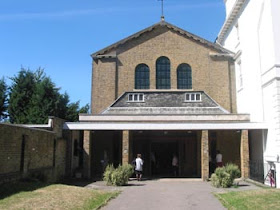unless otherwise stated.

Bede, translating the Gospel
of Saint John on his deathbed.
Date: 1902.
Author: James Doyle Penrose.
(Wikimedia Commons)
Bede's work as a hagiographer, and his detailed attention to dating, were both useful preparations for the task of writing the Historia Ecclesiastica. His interest in "Computus", the science of calculating the date of Easter, was also useful in the account he gives of the controversy between the British and Anglo-Saxon Churches over the correct method of obtaining the Easter date.

Saint Bede's Church (founded 1771),
Appleton, Cheshire,
England.
Photo: 27 March 2007.
Source: From geograph.org.uk.
Author: Sue Adair.
(Wikimedia Commons)
In the words of Charles Plummer, one of the best-known editors of the Historia Ecclesiastica, Bede's Latin is "clear and limpid ... it is very seldom that we have to pause to think of the meaning of a sentence ... Alcuin rightly praises Bede for his unpretending style."
Bede's primary intention, in writing the Historia Ecclesiastica, was to show the growth of the united Church throughout England. The native Britons, whose Christian Church survived the departure of the Romans, earn Bede's ire for refusing to help convert the Saxons; by the end of the Historia, the English, and their Church, are dominant over the Britons. This goal, of showing the movement towards unity, explains Bede's animosity towards the British method of calculating Easter: Much of the Historia is devoted to a history of the dispute, including the final resolution at the Synod of Whitby in 664 A.D. Bede is also concerned to show the unity of the English, despite the disparate kingdoms that still existed when he was writing. He also wants to instruct the reader by spiritual example, and to entertain, and, to the latter end, he adds stories about many of the places and people about which he wrote.

St. Bede's RC Church in Jarrow,
County Durham (now Tyne & Wear),
England.
Photo: 29 March 2007.
Source: From geograph.org.uk.
Author: Vin Mullen.
(Wikimedia Commons)
Bede is somewhat reticent about the career of Wilfrid, a contemporary, and one of the most prominent Clerics of his day. This may be because Wilfrid's opulent lifestyle was uncongenial to Bede's Monastic mind; it may also be that the events of Wilfrid's life, divisive and controversial as they were, simply did not fit with Bede's theme of the progression to a unified and harmonious Church.
Bede's account, of the early migrations of the Angles and Saxons to England, omits any mention of a movement of those peoples across the Channel from Britain to Brittany, described by Procopius, who was writing in the 6th-Ccentury. Frank Stenton describes this omission as "a scholar's dislike of the indefinite"; traditional material that could not be dated or used for Bede's didactic purposes had no interest for him.

Saint Bede's Catholic Church,
Clapham Park, London SW12 OLF.
Image: ST. BEDE'S CATHOLIC CHURCH
PART SIX FOLLOWS

No comments:
Post a Comment